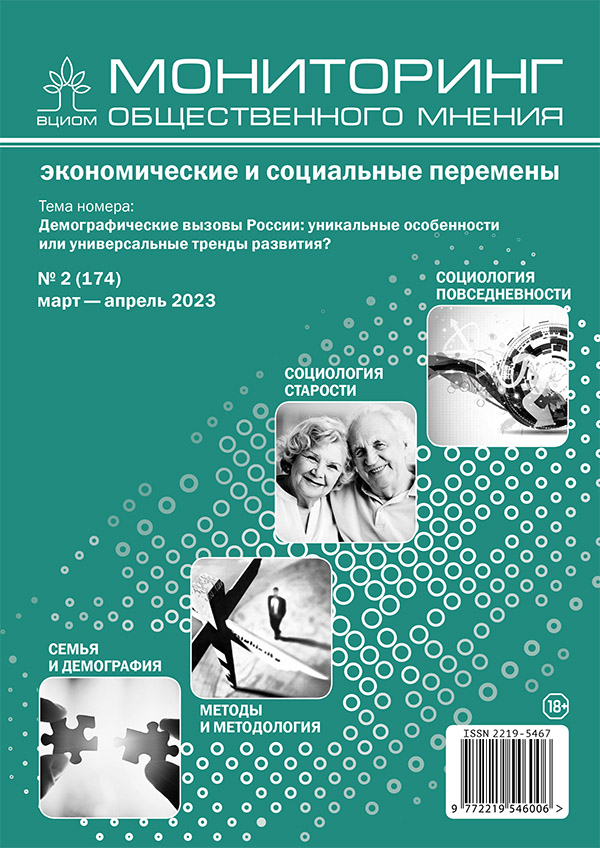Population Heterogeneity in the Number of Children Born: Is There a “Parity Transition”?
DOI:
https://doi.org/10.14515/monitoring.2023.2.2362Keywords:
fertility, parity progression ratio, fertility concentration, heterogeneity in parity, Human Fertility DatabaseAbstract
The paper studies the dynamics of fertility heterogeneity in terms of parities in the countries with a birth rate below replacement for cohorts of women born in 1960-1980 or earlier. Fertility heterogeneity is estimated using the distribution of women by birth order, the probabilities of having children of certain orders, and three fertility concentration indices. Empirically, the study bases on the Human Fertility Database data for 18 countries.
The authors show the existence of the so-called “parity transition”, which contains two stages, namely, a gradual decrease and subsequent increase in fertility heterogeneity in terms of parities. The study regards the contribution of different parities in the changes in heterogeneity that occur at these stages. Examination of data for five countries with a long period of observation showed that the first stage may be associated with a decrease in high-parity births, while the second stage is characterized by an increase in childlessness rate. The authors note that in the future this conclusion should be supported by a larger number of observations.
The study confirms the presence of the “Eastern European” and the “Western European” fertility models in the context of the population heterogeneity dynamics measured by the number of children born. The “Eastern European” fertility model remains even in the process of growing parity heterogeneity observed for the generations born in the second half of the 1970s. Its important feature is the relatively low level of fertility heterogeneity in terms of different parities, as well as less significant changes in fertility concentration in the process of “parity transition”.
Acknowledgments. The authors are grateful to two anonymous reviewers whose comments allowed us to significantly improve the text.
The research was conducted with the financial support of the Government research subsidy No. 122041800047 9 “The reproduction of the population in the context of the socioeconomic development”.
References
Тындик А. Демографическая повестка современной России: структура и воспроизводство населения. М.: РАНХиГС, 2021.
Tyndik A. (2021) Demographic Agenda of Modern Russia: Structure and Reproduction of the Population. Moscow: RANEPA.
Avdeev A. (2003) On the Way to a One-Child Family: Are We beyond the Point of No Return? Some Considerations Concerning the Fertility Decrease in Russia. In: Population of Central and Eastern Europe: Challenges and Opportunities, European Population Conference, Warsaw. P. 26—30.
Barakat B. (2014) Revisiting the History of Fertility Concentration and Its Measurement. Vienna Institute of Demography Working Papers. No. 1.
Barkalov N. B. (1999) The Fertility Decline in Russia, 1989-1996: A View with Period Parity-Progression Ratios. Genus. Vol. 55. No. 3/4. P. 11—60. URL: https://www.jstor.org/stable/29788609 (accessed: 29.03.2023).
Barkalov N. B. (2005) Changes in the Quantum of Russian Fertility during the 1980S and Early 1990s. Population and Development Review. Vol. 31. No. 3. P. 545—556. URL: https://www.jstor.org/stable/3401479 (accessed: 29.03.2023).
Devolder D., Reeve P. (2018) Relationships between Total and Birth Order-Specific Fertility Indicators: Application to Spain for the 1898-1970 Cohorts. Population. Vol. 73. No. 1. P. 61—88. https://doi.org/10.3917/popu.1801.0063.
Landry A. (1987) Adolphe Landry on the Demographic Revolution. Population and Development Review. Vol. 13. No. 4. P. 731-740.
Lesthaeghe R., Van de Kaa D. J. (1986) Twee demografische transities. Bevolking: groei en krimp. P. 9—24.
Lutz W. (1989) Distributional Aspects of Human Fertility. London: Academic press.
Notestein F. W. (1945) Population: The Long View. In: T. Schultz (ed.) Food for the World. Chicago: University of Chicago Press. P. 36-57.
Shkolnikov V. M., Andreev E. M., Houle R., Vaupel J. W. (2007) The Concentration of Reproduction in Cohorts of Women in Europe and the United States. Population and Development Review. Vol. 33. No. 1. Р. 67-99.
Van de Kaa D. J. (1987) Europe's Second Demographic Transition. Population bulletin. Vol. 42. No. 1. P. 1—59.
Vaupel J. W., Goodwin D. G. (1987) Concentration of Reproduction in Cohorts of Women, 1917-80. Population and Development Review. Vol. 13. No. 4. P. 723—730. https://doi.org/10.2307/1973030.
Yoo S. H. (2015) Convergence Towards Diversity? Cohort Analysis of Fertility and Family Formation in South Korea. A Dissertation Presented in Partial Fulfillment of the Requirements for the Degree Doctor of Philosophy. Arizona State University.
Zakharov S. (2017) The Modest Demographic Results of Pronatalist Policy against the Background of the Long-Term Evolution of Fertility in Russia. Demographic Review. Vol. 3. No. 5. P. 4—46. https://doi.org/10.17323/demreview.v3i5.7310.
Zeman K., Beaujouan É., Brzozowska Z., Sobotka T. (2018) Cohort Fertility Decline in Low Fertility Countries: Decomposition Using Parity Progression Ratios. Demographic research. Vol. 38. P. 651-690. https://dx.doi.org/10.4054/DemRes.2018.38.25.
Downloads
Published
How to Cite
Issue
Section
License
Copyright (c) 2023 Monitoring of Public Opinion: Economic and Social Changes Journal (Public Opinion Monitoring) ISSN 2219-5467

This work is licensed under a Creative Commons Attribution-NonCommercial-ShareAlike 4.0 International License.






